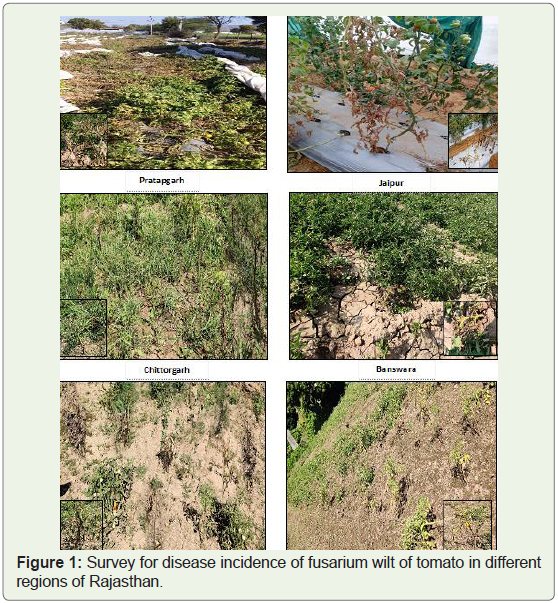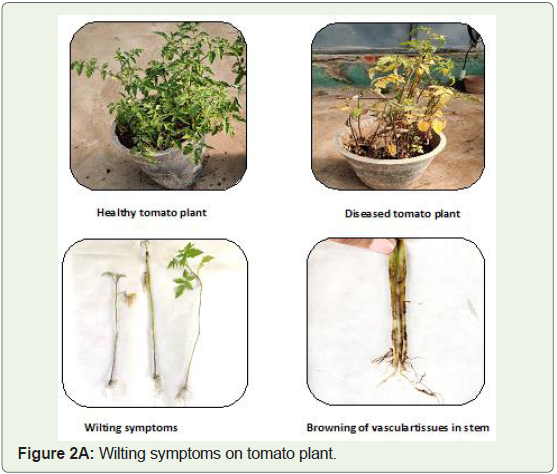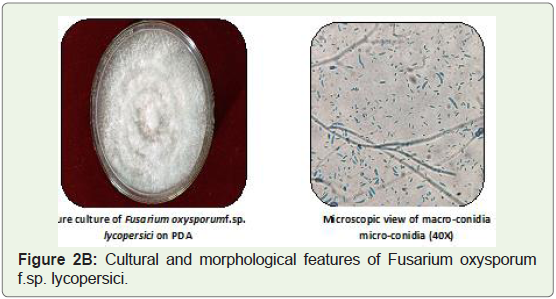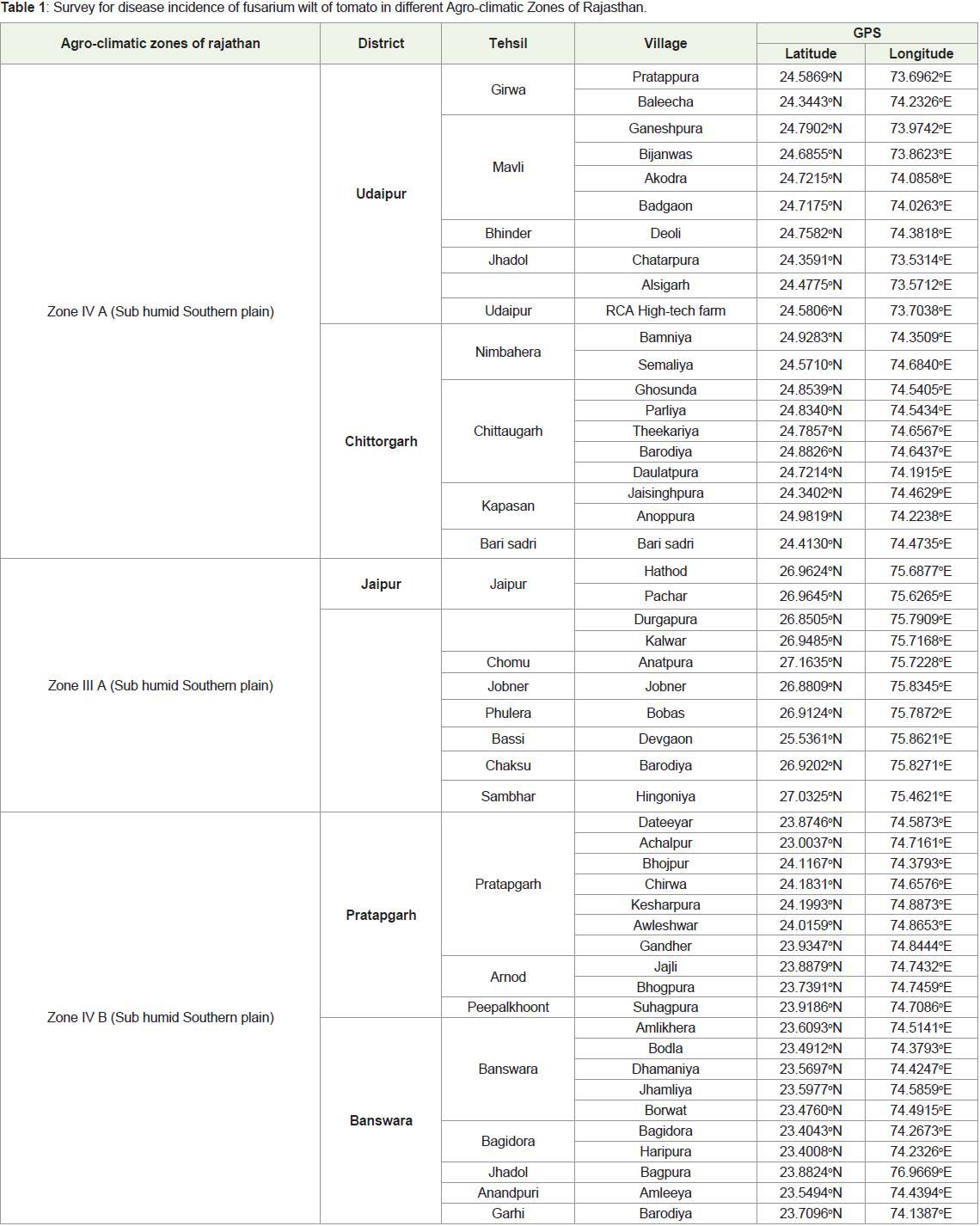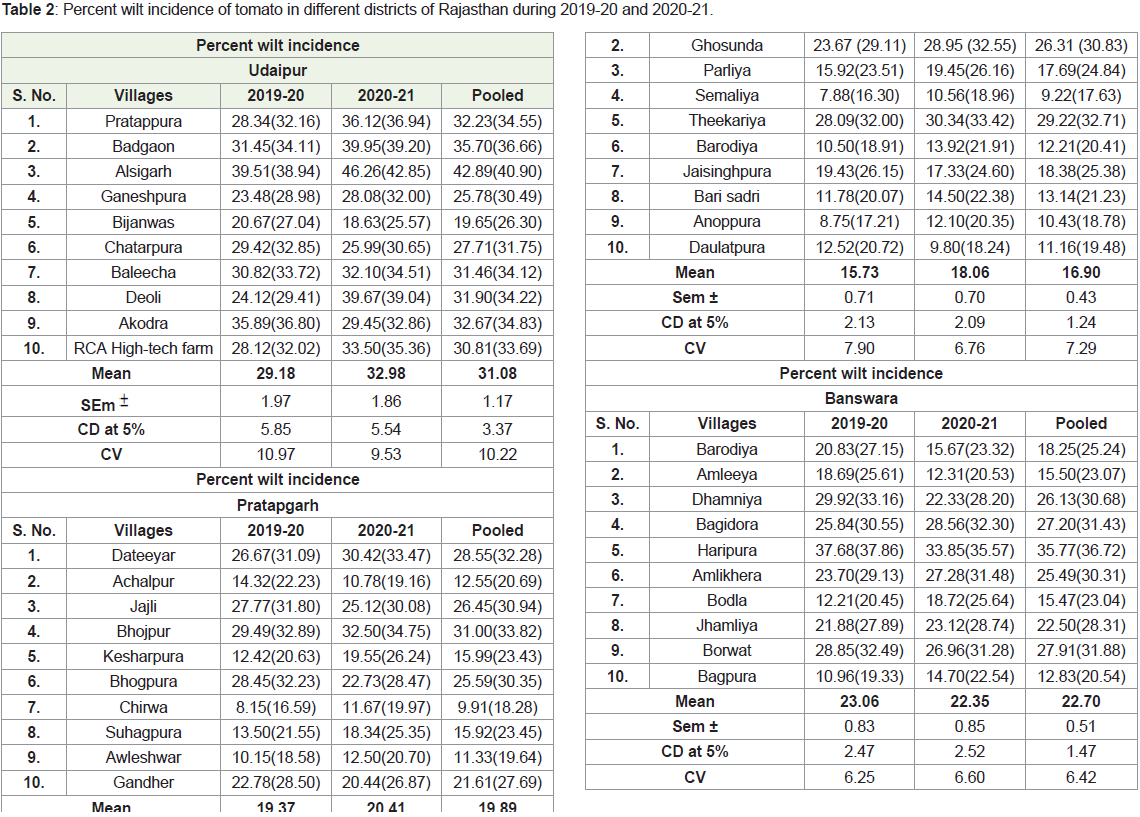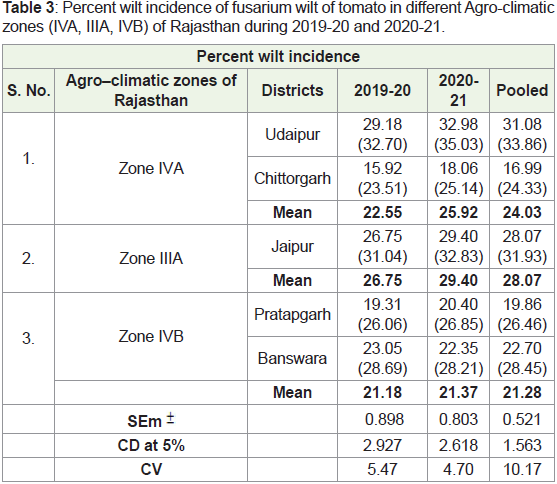Research Article
Survey and incidence of tomato wilt disease incited by Fusarium oxyspourum f.sp. lycopersici (Sacc.) in different Agro-climatic Zones of Rajasthan
Gahlot N*, Bunker RN, Abhinav and Charpota K
Department of Plant Pathology, Rajasthan College of Agriculture, Maharana Pratap University of Agriculture and Technology,
Udaipur, Rajasthan, India
*Corresponding author: Gahlot N, Department of Plant Pathology, Rajasthan College of Agriculture, Maharana
Pratap University of Agriculture and Technology, Udaipur, Rajasthan, India; E-mail: nitishagahlot560@gmail.com
Copyright: © Gahlot N, et al. 2022. This is an open access article distributed under the Creative Commons Attribution License,
which permits unrestricted use, distribution, and reproduction in any medium, provided the original work is properly cited.
Article Information: Submission: 11/05/2022; Accepted: 20/06/2022; Published: 22/06/2022
Abstract
Fusarium wilt or vascular wilt of tomato, caused by Fusarium oxysporum f.sp. lycopersici is one of the major constraints in tomato production. A survey
was carried out to assess the incidence and distribution of fusarium wilt in different Agro-climatic zones of Rajasthan in the year 2019-20 and 2020-21 (Figure 1). Total fifty villages of different agro-climatic zones were surveyed involving five fields of every village by counting infected or diseased plants in tomato field
of 5×5 m2 area of randomly selected from four to five places in each field. Highest wilt incidence was recorded in Zone IIIA (28.07%) followed by Zone IVA
(24.02%) while, lowest percent disease incidence was recorded by Zone IVB (21.28%). At districts level, maximum disease incidence was found in Udaipur
(31.08%) followed by Jaipur (28.07%) and Banswara (22.70%). Minimum wilt incidence was observed in Chittorgarh (16.99%) followed by Pratapgarh district
(19.86%). The survey results revealed that disease incidence was noticed causing loss in tomato crop and production.
Keywords
Survey; Tomato; Wilt disease; Fusarium oxysporum f.sp. lycopersici
Introduction
Tomato (Lycopersicon esculentum Mill.) belongs to the family
Solanaceae and it is viewed as one of the world’s most mainstream
vegetables [1-3]. It is widely grown throughout the world and
considered as most important tropical vegetable crop. A number of
biotic and abiotic factors affect the quality and productivity of tomato.
Fusarium wilt caused by Fusarium oxysporum f.sp.lycopersici (Sacc.)
W.C. Snyder and Hans a serious disease of tomato causes 30-40%
yield loss and under favorable conditions losses increased to 80%
[4]. Fusarium oxysporum is a soil borne pathogen by nature, which
gets entry through the roots and disturb vascular system of the plant
resulting yellowing, drooping and downward curvature of the leaves
and finally death of plant. Browning of vascular system in infected
stems and leaf petioles with larger size than normal, is strong evidence
of Fusarium wilt (Figure 2A and 2B). Survey and surveillance are the basic requirement to assess the incidence of any disease and distribution
of pathogen population and further studies on biology and variability
of the pathogen.
Material & Methods
A survey was carried out to know the severity of tomato wilt
during the year 2019-20 and 2020-21 in different Agro-climatic zones
(IVA, IIIA and IVB) of Rajasthan, which includes five districts viz.,
Udaipur, Chittorgarh, Jaipur, Pratapgarh and Banswara. Total fifty
villages were surveyed in all the five districts (Table 1). Observation on
percent disease incidence was taken by counting infected or diseased
plants in tomato field of 5×5 m2 area of randomly selected from four to
five places in each field by using the following formula.
Table 1: Survey for disease incidence of fusarium wilt of tomato in different Agro-climatic Zones of Rajasthan.
The disease samples were uprooted, collected and packed in
clean polythene bags along with rhizospheric soil of wilted plants
from farmer’s field then labeled and transferred to the laboratory for
isolation and identification of the pathogen.
Results & Discussion
Survey was carried out to know the severity of tomato wilt during
the year 2019-20 and 2020-21 in different Agro-climatic zones (IVA,
IIIA and IVB) of Rajasthan, which includes five districts viz., Udaipur,
Chittorgarh, Jaipur, Pratapgarh and Banswara. Total fifty villages were
surveyed which are mentioned in materials and methods and evident
from Table 2 and 3 The results of pooled data showed that percent disease
incidence of all five districts varied from 9.22% to 42.89% in both the
year [5,6].
Table 2: Percent wilt incidence of tomato in different districts of Rajasthan during 2019-20 and 2020-21.
Table 3: Percent wilt incidence of fusarium wilt of tomato in different Agro-climatic
zones (IVA, IIIA, IVB) of Rajasthan during 2019-20 and 2020-21.
In Udaipur district surveyed villages during 2019-20, showed
variation in percent disease incidence ranging from 20.67%
(Bijanwas) to 39.51% (Alsigarh). Highest percent disease incidence
was recorded in Alsigarh (39.51%) followed by Akodra (35.89%) and
Badgaon (31.45%). Minimum percent disease incidence was recorded
in Bijanwas (20.67%) followed by Ganeshpura (23.48%). The disease
incidence in left over villages was ranged from 24.12% (Deoli) to
30.82% (Baleecha).During 2020-21, ten villages of Udaipur districts
depicted percent disease incidence ranging 18.63% (Bijanwas) to
46.26% (Alsigarh). The maximum percent disease incidence was
showed by Alsigarh (46.26%) followed by Badgaon (39.95%) and Deoli
(39.67%) while, minimum percent disease incidence was showed by
Bijanwas (18.63%) followed by Chatarpura (25.99%). Percent disease
incidence in remaining villages was ranged from 28.08% (Ganeshpura)
to 36.12% (Pratappura).It is evident from pooled data that highest
percent disease incident was showed by Alsigarh (42.89%) followed
by Badgaon (35.70%) whereas, lowest percent disease incidence was
recorded by Bijanwas (19.65%) followed by Ganeshpura (25.78%).
During the survey in 2019-20 in villages of Pratapgarh percent
disease incidence range was found from 8.15% (Chirwa) to 29.49%
(Bhojpur). The maximum wilt incidence was found in Bhojpur
(29.49%) followed by Bhogpura (33.63%). The minimum wilt
incidence was showed by village Chirwa (28.26%) followed by
Awleshwar (10.15%).Survey done in 2020-21 showed that percent
wilt incidence ranged from 10.78% (Achalpur) to 32.50% Bhojpur).
The highest wilt incidence was depicted by Bhojpur (32.50%)
followed by Dateeyar (30.42%). The lowest wilt incidence was showed
by Achalpur (10.78%) followed by Chirwa (11.67%). Pooled data
revealed that maximum percent wilt incidence was found in Bhojpur
(32.50%) followed by Dateeyar (28.55%). Minimum disease incidence
was showed by Chirwa (9.91%) followed by Achalpur (12.55%).
Survey in Jaipur district which was carried out in ten villages
during 2019-20 showed variation from 45.19% (Devgaon) to 33.43%
(Hingoniya). The most disease incidence was found in Devgaon
(45.19%) followed by Bobas (44.17%) and least disease incidence
was found in Hingoniya (33.43%) followed by Durgapura (34.11%).
During survey 2020-21 among ten villages of Jaipur, maximum
percent wilt incidence was found in Devgaon (48.13%) followed by
Barodiya (43.57%), while minimum wilt incidence was found in
Durgapura (32.73%) followed by Hingoniya (36.53%). From pooled
data it is depicted that maximum wilt incidence concluded in Devgaon
(46.66%) followed by Bobas (42.61%) while minimum wilt incidence
concluded in Durgapura (33.42%) followed by Hingoniya (34.98%).
In Chittorgarh, among surveyed ten villages in 2019-20 wilt incidence fluctuated between 7.88% (Semaliya) to 28.09%
(Theekariya). In which maximum wilt incidence found in Theekariya
(28.09%) followed by Ghosunda (23.67%). Minimum wilt incidence
was shown by Semaliya (7.88%) followed by Anoppura (8.75%). In
2020-21 survey data of percent wilt incidence in Chittorgarh villages,
it was found 9.80% (Daulatpura) which was extended up to 30.34%
(Theekariya). Highest wilt incidence showed by Theekariya (30.34%)
followed by Ghosunda (28.95%). Minimum wilt incidence found
in Daulatpura (9.80%) followed by Semaliya (10.56%). Pooled data
depicted highest wilt incidence in Theekariya (29.22%) followed by
Ghosunda (26.31%). Lowest wilt incidence depicted in Semaliya
(9.22%) followed by Anoppura (10.43%)
In Banswara survey data 2019-20, ten villages showed wilt
incidence varied from 10.96% (Bagpura) to 37.68% (Haripura).
Maximum wilt incidence found in Haripura (37.68%) followed by
Dhamniya (29.92%). Minimum wilt incidence found in Bagpura
(10.96%) followed by Bodla (12.21%).Survey data 2020-21 of wilt
incidence ranged from 12.31% (Amleeya) to 33.85% (Haripura).
Highest wilt incidence showed by Haripura (33.85%) followed
by Bagidora (28.56%). Lowest wilt incidence showed by Amleeya
(12.31%) followed by Bagpura (14.70%). Pooled depicted highest
wilt incidence in Haripura (35.77%) followed by Bagidora (27.20%),
lowest wilt incidence found in Bagpura (12.83%) followed by Bodla
(15.47%).
All five districts of different Agro-climatic zones (IV A, III A
and IV B) showed variation in percent wilt incidence of tomato wilt
during two consecutive years 2019-2020 and 2020-21. During 2019-
20 maximum percent disease incidence was depicted in Agro-climatic
Zone IIIA (26.75%) followed by Zone IVA (22.55%). Minimum
percent disease incidence was showed by Zone IVB (21.18%). During
2020-21 highest disease incidence was showed by Agro-climatic zone
IIIA (29.40%) followed by Zone IVA (25.92%). Minimum percent
disease incidence was showed by Zone IVB (21.37%). In pooled data
maximum disease incidence recorded in Agro-climatic zone IIIA
(28.07%) followed by Zone IVA (24.02%). Minimum (21.28) percent
disease incidence was recorded in Zone IVB (Table 3). Such reports on survey documented by Kapoor (1988) from different agro-climatic
regions of India (Delhi, Maharashtra and Tamil Nadu) in 1981-1983
and recorded 3 to 100% disease incidence on eight tomato cultivars.
Similarly, Khan et al. (2016) recorded 10.67% to 80.34% wilt incidence
in different districts of Uttar Pradesh for fusarium wilt of tomato.
Conclusion
It is concluded Fusarium wilt disease of tomato, caused by
Fusarium oxysporum f.sp. lycopersici (Sacc.) is one of the major
constraints in tomato production. Survey results showed prevalence
and disease severity in different Agro-climatic Zones and highest in
Zone IIIA [7].
Acknowledgement
The authors gratefully acknowledge, Department of Plant
Pathology, Rajasthan College of Agriculture,Udaipur (Rajasthan), for
providing the facilities to carry out the research work. This study was
performed as part of the first author’s Ph.D. dissertation.

